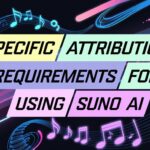Suno AI, a generative music platform, has revolutionized how people create songs by transforming text prompts into full tracks with vocals and instrumentation. However, its approach to copyright compliance has sparked significant debate and legal challenges. Here’s a detailed analysis of how Suno navigates copyright issues, based on current practices and ongoing disputes.
Suno’s Copyright Compliance Framework
Suno’s strategy to address copyright revolves around three pillars: training data claims, user agreements, and technical safeguards. However, these measures are under intense scrutiny from the music industry and legal experts.
1. Training Data and the Fair Use Defense
Suno’s AI model is trained on vast amounts of music sourced from the open internet, including copyrighted material. The company argues this falls under fair use, a legal doctrine permitting limited use of copyrighted works for purposes like education, research, or transformative creation.
- Key Claims:
- Suno CEO Mikey Shulman likened the AI’s learning process to “a child learning to write rock songs after listening to the genre.”
- The company asserts that its model produces original compositions rather than direct copies, avoiding plagiarism.
- Criticisms:
- The Recording Industry Association of America (RIAA) labels this practice “industrial-scale infringement,” arguing that AI-generated songs compete with original works and harm artists.
- Legal experts highlight flaws in Suno’s analogy: unlike a child, Suno is a commercial entity profiting from copyrighted material without licensing agreements.
2. User Agreements and Ownership Rights
Suno’s terms of service define ownership rules for generated music, varying between free and paid users:
| User Type | Rights Granted | Restrictions |
|---|---|---|
| Free Users | Non-commercial use with attribution to Suno | Cannot monetize or claim ownership |
| Paid Subscribers | Full ownership of sound recordings | Must comply with terms (e.g., no copyrighted material in prompts) |
This structure aims to limit liability by placing responsibility on users to avoid infringing content. However, ambiguities persist:
- Australian copyright law, for example, requires a human “creative spark” for ownership—a standard AI-generated music might not meet.
- Udio, a competitor, allows unrestricted use of its outputs but warns users against incorporating copyrighted material.
3. Technical Safeguards
Suno claims to employ tools to prevent direct replication of copyrighted works:
- Filters: “State-of-the-art” systems allegedly block prompts referencing specific artists or songs.
- Post-Generation Checks: AI compares outputs against known copyrighted material to flag similarities.
Critics argue these measures are insufficient. Examples of AI-generated tracks containing recognizable producer tags or stylistic imitations suggest gaps in these safeguards.
Ongoing Legal Battles and Industry Pushback
In June 2024, Universal Music Group, Sony, and Warner sued Suno and Udio for copyright infringement, seeking up to $150,000 per infringed work. The lawsuits allege:
- Suno’s ability to mimic “human musical expression” proves unauthorized use of copyrighted recordings.
- The company refused transparency about its training data, calling it “confidential business information.”
Potential Outcomes
- Fair Use Precedent: If courts side with Suno, AI companies could gain legal cover to train models on copyrighted material without licenses.
- Licensing Requirements: A ruling favoring record labels might force AI firms to negotiate data-licensing deals, similar to partnerships between OpenAI and media companies.
Ethical and Creative Implications
The debate extends beyond legality into broader ethical concerns:
- Artist Compensation: Musicians fear AI-generated music could devalue their work or replicate their style without consent.
- Creative Control: Suno’s tools democratize music creation but risk homogenizing artistry by prioritizing algorithm-friendly patterns.
The Path Forward
To balance innovation and copyright protection, stakeholders propose:
- Licensing Frameworks: Clear agreements between AI companies and rights holders, ensuring fair compensation.
- Transparency: Disclosing training data sources and allowing artists to opt out.
- Collaboration: Joint ventures between AI developers and musicians to enhance—not replace—human creativity.
Conclusion
Suno AI’s copyright compliance hinges on untested legal arguments about fair use, user agreements, and technical checks. While the platform empowers creators, its reliance on copyrighted training data without licenses has ignited a high-stakes battle over AI’s role in creative industries. The outcome of ongoing lawsuits will likely reshape how AI companies operate, emphasizing the need for ethical practices that respect artists’ rights while fostering innovation.
As the legal landscape evolves, Suno’s ability to adapt—whether through licensing, improved safeguards, or revised business models—will determine its longevity in an industry demanding accountability. For now, users should tread carefully, understanding the unresolved risks of AI-generated music in a world where copyright law struggles to keep pace with technology.



